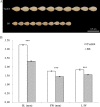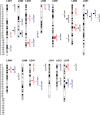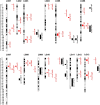QTL analysis of traits related to seed size and shape in sesame (Sesamum indicum L.)
- PMID: 37917626
- PMCID: PMC10621824
- DOI: 10.1371/journal.pone.0293155
QTL analysis of traits related to seed size and shape in sesame (Sesamum indicum L.)
Abstract
Seed size and shape are important traits that determine seed yield in sesame. Understanding the genetic basis of seed size and shape is essential for improving the yield of sesame. In this study, F2 and BC1 populations were developed by crossing the Yuzhi 4 and Bengal small-seed (BS) lines for detecting the quantitative trait loci (QTLs) of traits related to seed size and shape. A total of 52 QTLs, including 13 in F2 and 39 in BC1 populations, for seed length (SL), seed width (SW), and length to width ratio (L/W) were identified, explaining phenotypic variations from 3.68 to 21.64%. Of these QTLs, nine stable major QTLs were identified in the two populations. Notably, three major QTLs qSL-LG3-2, qSW-LG3-2, and qSW-LG3-F2 that accounted for 4.94-16.34% of the phenotypic variations were co-localized in a 2.08 Mb interval on chromosome 1 (chr1) with 279 candidate genes. Three stable major QTLs qSL-LG6-2, qLW-LG6, and qLW-LG6-F2 that explained 8.14-33.74% of the phenotypic variations were co-localized in a 3.27 Mb region on chr9 with 398 candidate genes. In addition, the stable major QTL qSL-LG5 was co-localized with minor QTLs qLW-LG5-3 and qSW-LG5 to a 1.82 Mb region on chr3 with 195 candidate genes. Gene annotation, orthologous gene analysis, and sequence analysis indicated that three genes are likely involved in sesame seed development. These results obtained herein provide valuable in-formation for functional gene cloning and improving the seed yield of sesame.
Copyright: © 2023 Mei et al. This is an open access article distributed under the terms of the Creative Commons Attribution License, which permits unrestricted use, distribution, and reproduction in any medium, provided the original author and source are credited.
Conflict of interest statement
The authors have declared that no competing interests exist.
Figures



Similar articles
-
A high-density genetic map constructed using specific length amplified fragment (SLAF) sequencing and QTL mapping of seed-related traits in sesame (Sesamum indicum L.).BMC Plant Biol. 2019 Dec 27;19(1):588. doi: 10.1186/s12870-019-2172-5. BMC Plant Biol. 2019. PMID: 31881840 Free PMC article.
-
Genetic analysis and QTL mapping of seed coat color in sesame (Sesamum indicum L.).PLoS One. 2013 May 21;8(5):e63898. doi: 10.1371/journal.pone.0063898. Print 2013. PLoS One. 2013. PMID: 23704951 Free PMC article.
-
High-density genetic map construction and QTLs analysis of grain yield-related traits in sesame (Sesamum indicum L.) based on RAD-Seq techonology.BMC Plant Biol. 2014 Oct 10;14:274. doi: 10.1186/s12870-014-0274-7. BMC Plant Biol. 2014. PMID: 25300176 Free PMC article.
-
QTL mapping in sesame (Sesamum indicum L.): A review.J Biotechnol. 2023 Nov 10;376:11-23. doi: 10.1016/j.jbiotec.2023.09.003. Epub 2023 Sep 15. J Biotechnol. 2023. PMID: 37717598 Review.
-
Discovering favorable genes, QTLs, and genotypes as a genetic resource for sesame (Sesamum indicum L.) improvement.Front Genet. 2022 Nov 1;13:1002182. doi: 10.3389/fgene.2022.1002182. eCollection 2022. Front Genet. 2022. PMID: 36544489 Free PMC article. Review.
References
-
- Ashri A. Sesame breeding. In: Janick J. Editor(s). Plant Breeding Reviews. New York: John Wiley & Sons Inc; 1998; pp.179–228.
Publication types
MeSH terms
LinkOut - more resources
Full Text Sources
Miscellaneous

